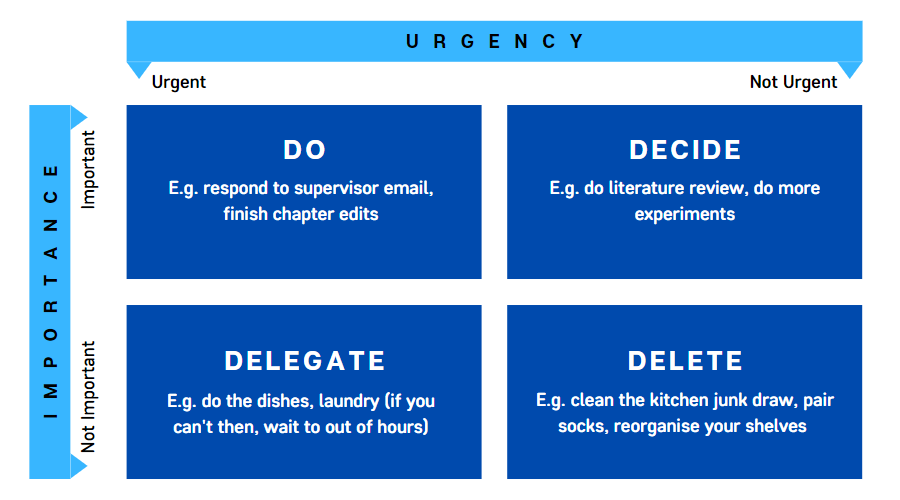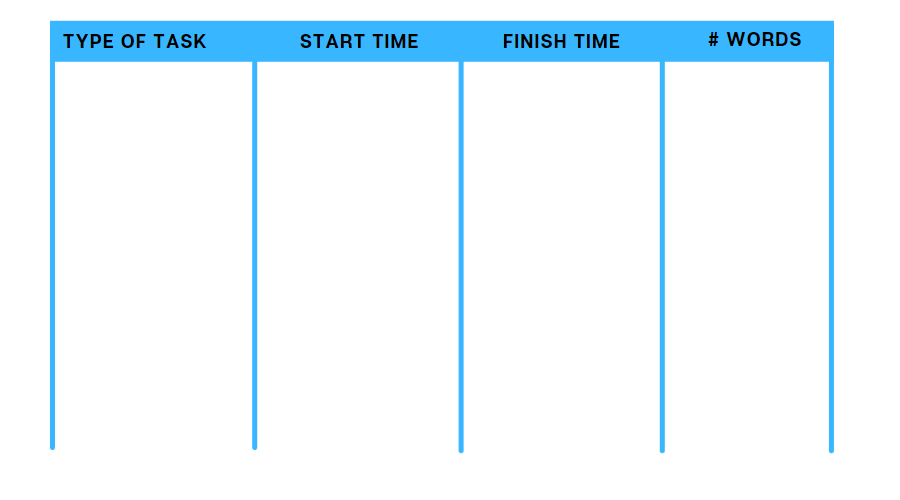This blog was first published on the Thesis Whisperer Website on the 6th October 2021 – Find the original and more great content at https://thesiswhisperer.com/
Lately, I’ve been getting a lot of requests to run my workshop called ‘How to finish that big writing project (and get on with your life)’. I’m guessing it’s a sign of pandemic fatigue: everyone close to the end of a PhD just wants it to be, well – over. I feel you. I’m not sure why, but the vast majority of PhD students have not been explicitly taught to plan a project and manage a diary full of competing commitments. As a consequence, only about 20% of PhD students finish ‘on time’. Most people finish between 4 and 5 years after starting. I trained as an architect, so I learned sophisticated project management techniques to deliver building projects. These same strategies work for managing writing projects. Here’s how I plan out a large writing project: simply using my diary and some handy planning tools.
Out of your head and onto a page – and ranked.
Your writing does not take place in a vacuum: life carries on. There’s a lot of hidden organisational work in everyday activities like connecting with loved ones, walking the dog, watering the plants, keeping the pantry stocked and making sure you always have a clean mask in your handbag. Some of us also have to manage all this AND chronic medical conditions / disabilities. All this is made more complex if you are living in a world built for neurotypicals and you don’t identify that way.
A large writing project deadline seems like it’s a long way away until suddenly… it’s not. Even experienced writers end up with a big pile of words at the end that need to be written or wrangled into shape.
Unhelpful advice for time-strapped writers abounds on the internet: like ‘get up at 4am to make time for writing before the family is awake’. Ok, maybe this works for some people! But for the rest of us mortals, setting an impossibly high standard for yourself usually leads to feeling terrible when you fail to stick at it. Better to try and map a course for meeting the deadline with realistic assumptions – and negotiate for more time if you need it.
Being in a deadline crisis is a bit like running out of money. The first thing you need to do is to work out exactly where time is being spent. Start by making a big ‘master list’ of everything that’s going on and your writing goals. Don’t categorise: just consult your diary and then write whatever else comes into mind. The master list will end up being a jumble of work stuff like ‘do chapter 3’ and life stuff like ‘make dentist appointment’.
Then map the individual list items using the 4 part Eisenhower matrix, shown below. The matrix has two axes against which you rank the task: urgency and importance.
The ‘urgent and important’ stuff needs to be done right away. The ‘not urgent, but still important’ needs to be scheduled. Then you need to work out if you can delegate any of the ‘urgent but not important’ (this is stuff like housework and chores). Anything that falls in the ‘not urgent and not important’ category should just be crossed off if you are on deadline.

Put all your appointments and non-writing commitments in the calendar as time blocks: calendar entries that are large enough to get the task done. Be ruthlessly pessimistic about time estimates so the time blocks are big enough.
For example, my back needs constant maintainance by my osteopath or I cannot write. It’s at least 20 minutes travel each way to my specialist, and an hour of actual manipulation. I add an extra 20 minutes for getting out the door and refocussing on task when I get back to my desk. That’s two hours of actual elapsed time.
What is left in your diary should be the time you actually have to do writing. A more detailed analysis will tell you how much writing you can get done in that time.
Do a realistic ‘time on task’ analysis
Most people, including me, are really really bad at working out how long it will take them to write a piece, be it a blog post or chapter. It really pays to get better at this – your life will be much less stressful.
The best way to project forward accurately is to base it on what happened in the past. I use a program called Timing to measure how long I spend on specific kinds of tasks. You can achieve the same result using a notebook with columns: type of task, start time, stop time and number of words written, like so:

Observe yourself working for at least a month and gather some baseline data on different types of writing tasks.
Writing a discussion section of a paper, for example, will probably take a lot longer than writing the results. Writing a book chapter takes me about four times longer than writing a blog post because I read and look things up as I go (for some reason, blog posts come out almost perfectly formed in a big word spew!).
Editing will take more or less time than writing the first draft, depending on how messy you let your first draft be. I’m a ‘make a mess and then clean it up’ writer so my editing takes six times longer than my drafting. Anyway, my point is: it’s highly idiosyncratic. While there are ways to improve your quality and write faster, be realistic and start with what you do now.
You might be able to work out a rough words per hour rate by looking at your past performance, but, if you’re a human, you probably have good days and bad days. You can accommodate this variation by using a more sophisticated estimation method called the ‘Program evaluation and review technique’ or PERT.
PERT is basically a formula that you plug numbers into. You’ll need to start with three types of time estimate:
- Most Likely Estimate – your most commonly recorded time (Tm)
- Optimistic Estimate – your best recorded time (To)
- Pessimistic Estimate – your worst recorded time (Tp)
To work out an estimate that accommodates this variation, plug these numbers in the formula below:
(To + 4Tm + Tp) / 6 = PERT time estimate
If you want to go a step further, you can work out the standard deviation by plugging these numbers into the following formula:
(Tp – To) / 6 = PERT standard deviation
While you can assign diary time to specific tasks, I find it works best just to smoosh it all together and come up with a total time estimate for the project. Look at your diary again, break the total time up into two or three-hour blocks. Try to fit these time blocks in the remaining diary space. Leave yourself time for lunch!
Now… sanity check time. Can you fit it all in – or not?
Ideally, you should only have to work 35 to 40 hours a week on a full time PhD (half that for a part time PhD). If you need to work seven days a week for months and months get this writing done by deadline, you don’t have enough time. You’ll need to revisit the deadline, or move other commitments aside.
But you have one more thing to do before you commit to the path. You must work out the time impact of working with other people.
3) Map the dependencies.
All published writing will be reviewed by someone else. For a published book it’s the publisher’s chosen reviewers and/or an editor. For a thesis, it’s at least two supervisors and maybe a circle of trusted critical friends.
You need two bits of information from other people to plan this time in properly:
Lead time: how much time does the person need before they can look at the writing? No point sending someone a chapter while they are on holiday. You might as well have that extra time to write and send it to them when they are back.
Turn-around time: how much time they will need to spend reviewing your writing? Ideally, the person should be able to commit to a date when they will get the marked-up version back to you.
Most writing schedules slip because writers and reviewers don’t communicate honestly and clearly. It’s the turn-around time that’s most troublesome for PhD students in my experience. Academics seem desperately terrible at planning reviewing time and try to squeeze it into their home or travel time. The only thing you can do is work parallel pieces of writing at the same time, so you can switch onto another task while you wait.
In case you were wondering, yes – I do teach these techniques and more at other universities, but I can only do a very limited number of private gigs each year. Feel free to use the slide deck to run your own session if you like (it’s released with a creative commons license).
Good luck!
The Thesis Whisperer is written by Professor Inger Mewburn, director of researcher development at The Australian National University. New posts on the first Wednesday of the month. Subscribe by email below. Visit the About page to find out more about me and my books. Listen to my podcasts: On the Reg , Your brain on writing and WhisperCollective. Send me a message on Speakpipe.

 Print This Post
Print This Post




